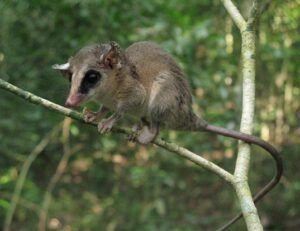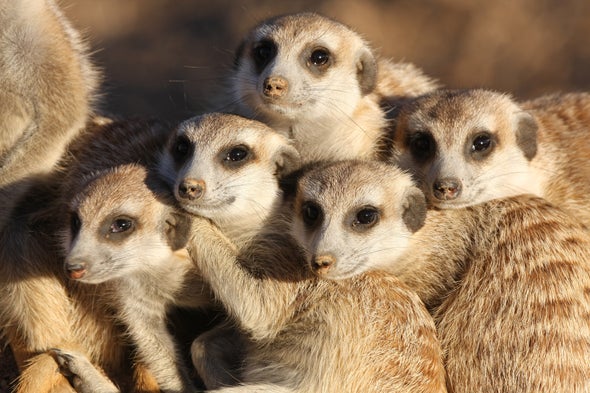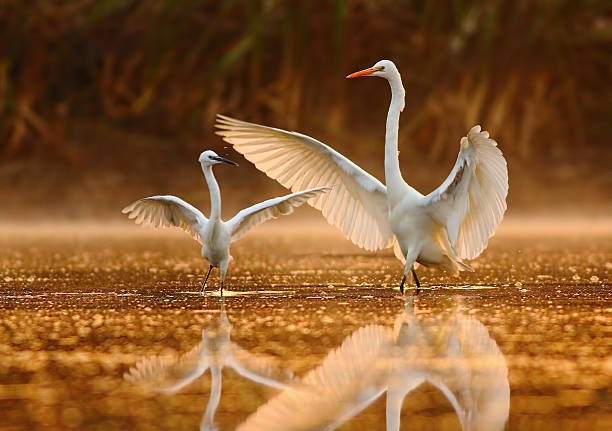Virginia opossum (North American opossum)
INTRODUCTION
Hi, I’m a Virginia opossum. We are commonly known as the North American opossum, highly adaptable, and actively expanding our range in North America. We have a long head and pointed snout, rounded naked ears, and a scaly, nearly hairless, prehensile tail that is about half of our length. Our fore and hind feet have five toes, all with sharp claws except for the clawless, thumblike, opposable innermost toe on the hind feet. We get benefits from human habitation, both for shelter because we nest in piles of debris or outbuildings, and for food because we scavenge for scraps. We are true omnivores, our protein-filled diet ranges from grubs and eggs to flowers, fruits, and carrion; we may raid farm poultry and damage garden plants. We like to stay in temperate forests, including woodland, tropical forest, and rainforest, open habitats, including grassland, moor, heath, savanna, fields, and scrub, urban areas, including buildings, parks, and gardens. We are the largest American marsupial, nocturnal, and usually terrestrial, but also climb well and swim strongly. Even though we are not territorial, our individuals avoid each other except when breeding. When we are threatened, we feign death in an attempt to make predators lose interest in us. We may lie immobile, partly curled on our side, for up to 6 hours. Our mouth and eyes are open and we do not respond to stimuli, including touch. We may void a foul-smelling fluid from our anus for the added effect of death. Our breeding season begins as early as December and continues through October with most young born between February and June. My female bears up to 21 per litter, yet she has only enough teats for 13. The survivors attach to the teats for 48 – 65 days, leaving the pouch at 70 days.
- AVG. READING TIME: 8 MINUTES
- UPDATE: 10/04/2022
DIET : Grubs, eggs, flowers, fruits, and carrion
HABITAT : Temperate forests, including woodland, tropical forest, and rainforest, open habitats, including grassland, moor, heath, savanna, fields, and scrub, urban areas, including buildings, parks, and gardens
SOCIAL UNIT : Individual
LOCATIONS : W. C. and E USA, Mexico Central America
STATUS / POPULATION : Least Concern (IUCN) Low-risk category that includes widespread and common species / Unknows
MAMMALS: MARSUPIALS
KEY FACTS

SCIENTIFIC CLASSIFICATION
Kingdom – Animalia
Phylum – Chordate
Class – Mammals
Order – Didelphimorphia Gill
Family – Didelphidae Gray
Genus – Didelphis Linnaeus
Genus Species – Didelphis virginiana Kerr
INTERESTING FACTS
1- The opossum has been around for at least 70 million years and is one of Earth’s oldest surviving
-
CALLING NAMES / SCIENTIFIC NAME
Calling name: Virginia opossum, North American opossum
Scientific Name: Didelphis virginiana -
COLOUR VARIATIONS
The Virginia opossum is about the size of a cat. It has two color phases (1) grayish and (2) blackish; basal fourth or more of tail black, terminal section whitish; legs and feet blackish, toes often white or whitish
-
LIFE SPAN : CAPTIVITY / WILD
Captivity: 4 year average
Wild: 2 year average -
APPROXIMATE SIZE : LENGTH / HEIGHT
Length: 33 - 50cm (13 - 20in)
Height: Estimated (2 - 5 inches) -
TAIL
25 - 54cm (10 - 21in)
-
WEIGHT
0.5 - 6kg (1 - 13Ib)
-
MIGRATION
No migration
-
SEX IDENTIFICATION
Male: Male possums are noticeably larger than females
Female: You can tell a male apart from a female by the color of the male's chest hair -
BREEDING SEASON
The breeding season for the Virginia opossum can begin as early as December and continue through October with most infants born between the months of February and June. in amarica
-
REPRODUCTION / GESTATION PERIOD
Reproduction: twice a year
Gestation period: 12 - 13 days -
CLUTCH / LITTER SIZE
21 Young
-
SIMILAR SPECIES
Water opossum
-
LOOK A LIKE
Cat and Rats
-
FARM ANIMAL
No
-
FOUNDED IN / DISCOVERED
The opossum has been around for at least 70 million years
-
ORIGIN
Eastern United States
-
DISTRIBUTION
The Virginia opossum occurs from southern Canada to northern Costa Rica. Populations in western Canada and along the Pacific coast south to northern Baja California, Mexico
-
OCCURRENCE
Families: 19
Species: 363 -
FUEL FOR LIFE / TROPHIC LEVEL
Omnivorous
-
SIGNS / MARKS
When threatened, the Virginia opossum feigns death in an attempt to make predators lose interest. It may lie immobile, partly curled on its side, for up to 6 hours. The mouth and eyes are open, and it does not respond to stimuli, including touch. It may void a foul-smelling fluid from its anus for added effect.
-
PREDATORS
Owls, hawks, red foxes, cats, dogs and humans
-
AVAILABLITY IN ZOO / MUSEUM
Smithsonian’s National Zoo & Conservation Biology Institute have Virginia opossum
-
TO HUMANS
Not dangerous
-
AS A PET
Not recommended
-
KIDS FAVOURITE
Yes, Virginia opossum also appears in Opossum in My Pocket. cartoon





